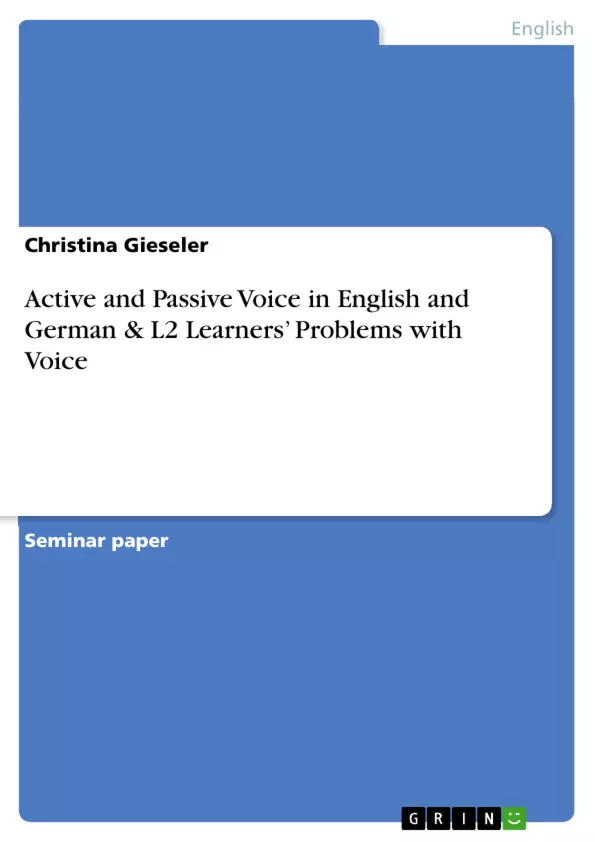In how far are active and passive voice in English and German different from each other? What difficulties do learners of English as a second language have to face when they deal with “voice”, especially in academic writing? This paper intends to answer these questions by firstly dealing with the descriptions and comparisons of active and passive voice, and partly also middle voice, as far as they are presented in Understanding English-German Contrasts by König & Gast. In a second step, certain exemplary problems that L21 learners of English come across when dealing with active and passive voice will be picked from Hinkel’s Teaching Academic ESL Writing: Practical Techniques in Vocabulary and Grammar. These problems will then be examined by referring back to the text by König & Gast.
Inhaltsverzeichnis (Table of Contents)
- Active and Passive Voice in English and German & L2 Learners' Problems with Voice
- Introduction
- Active and Passive Voice in English and German
- L2 Learners' Problems with Voice
Zielsetzung und Themenschwerpunkte (Objectives and Key Themes)
This paper aims to analyze the differences between active and passive voice in English and German, and explore the difficulties faced by learners of English as a second language (L2) when dealing with voice, particularly in academic writing. The paper focuses on the descriptions and comparisons of active, passive, and middle voice, drawing upon the work of König & Gast. It further examines specific issues encountered by L2 learners in using passive voice based on Hinkel's research.
- Contrasting active, passive, and middle voice in English and German
- Examining L2 learners' challenges in using passive voice in English
- Analyzing the role of passive voice in academic writing
- Exploring semantic and stylistic differences between active and passive constructions
- Highlighting specific linguistic features that contribute to L2 learners' difficulties with voice.
Zusammenfassung der Kapitel (Chapter Summaries)
The paper begins by introducing the concept of "voice," defining it as a linguistic feature that relates to the argument structure of predicates. It then delves into the active and passive voice, highlighting their frequent usage in English and German, and emphasizing the importance of understanding their differences in forming passive sentences. The paper discusses the grammatical changes involved in constructing a passive sentence from an active one, including the demotion of the subject to an adjunct, the promotion of the object to subject status, and the introduction of an auxiliary verb.
The paper further explores the use of passive voice in scholarly texts and its implications for academic writing. It discusses the limitations of passive constructions in English, highlighting the requirement for a "true patient" and the restriction to transitive verbs. Key differences between English and German passive formation are presented, particularly regarding subjectless sentences and the use of auxiliaries like "bekommen" and "kriegen" in German.
Finally, the paper examines L2 learners' difficulties in using passive voice, highlighting challenges related to idiomatic expressions, the influence of first language grammar, and the limitations of certain verb types. It concludes by emphasizing the importance of recognizing the stylistic and semantic differences between active and passive constructions, particularly in academic writing.
Schlüsselwörter (Keywords)
The paper focuses on active and passive voice, L2 learners, academic writing, English and German syntax, contrastive linguistics, voice, diathesis, grammatical function, argument structure, transitivity, valency, auxiliary verb, subjectless sentences, unaccusative verbs, stylistic and semantic differences, lexicalization, idiomatic expressions, first language influence, and academic discourse conventions.
- Quote paper
- Christina Gieseler (Author), 2008, Active and Passive Voice in English and German & L2 Learners’ Problems with Voice, Munich, GRIN Verlag, https://www.grin.com/document/148682



